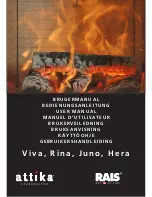
Use and maintenance manual Aria
Pag.50
Rev.0 22/04/2022
EN
TROUBLESHOOTING
The appliance does not work
•
Closely follow the directions in the dedicated chapter of this manual;
•
make sure that the air intake duct is not obstructed;
•
make sure that the smoke evacuation system is clean and not obstructed;
•
make sure the chimney is sized for the appliance power;
•
make sure that the air intake in the room is clear of any obstructions and that there are no other combustion appliances or
extraction hoods that create a vacuum in the room;
Difficult lighting
•
Closely follow the directions in the dedicated chapter of this manual;
•
make sure that the air intake duct is not obstructed;
•
make sure that the smoke evacuation system is clean and not obstructed;
•
make sure the chimney is sized for the appliance power;
•
make sure that the air intake in the room is clear of any obstructions and that there are no other combustion appliances or
extraction hoods creating a vacuum in the room.
Smoke leakage
•
Check the draught of the chimney;
•
check whether the seals on the door, drawer and smoke evacuation system are intact;
•
make sure there is no ash obstructing the primary air flow grille.
The glass gets dirty easily
•
Only use recommended fuels;
•
check the draught of the chimney.
Downtime (end of season)
At the end of every season we recommend vacuuming out any ash and dust that may still be inside. It is advisable to let the pellets
burn out in the tank so that the pellet remains and sawdust can be vacuumed from the bottom and from the screw.
Disconnect the appliance from the power supply.
With thermo-stove or boiler, it is not necessary to empty it of water, but it is advisable to close the shut-off valves at the inlet and outlet
for prolonged downtime.
DISPOSAL AT END OF SERVICE LIFE
Warnings for the correct disposal of the product
Demolition and disposal of the appliance is under the exclusive liability and responsibility of the owner who must do so in accordance
with the laws in force in the country of installation pertaining to safety, respect and protection of the environment.
At the end of its service life, the product must not be disposed of as household waste. It can be taken to designated separate waste
collection centres run by local administrations or to dealers who offer this service.
Disposing of the product as sorted waste avoids any negative consequences on the environment and health deriving from unsuitable
disposal and it recovers the materials that the stove is composed of in order to save considerable energy and resources.
The following table and relative exploded view (image for illustrative purposes only) to which it refers, highlights the main parts that
can be found in the device and the instructions for their correct separation and disposal at the end of their service life.
In particular, electric and electronic parts must be separated and disposed of at centres authorised for such activities, pursuant to
directive WEEE 2012/19/EU and its national transpositions.
A
EXTERNAL
CLADDING
If present, dispose of it according to the material it is made of:
- Metal
- Glass
- Tiles or ceramic
- Stone
- Wood
B
DOOR GLAZING
If present, dispose of it according to the material it is made of:
- Glass-ceramics (fire door): dispose of with inert or mixed waste
- Tempered glass (oven door): dispose of in glass
C
INTERNAL
CLADDING
If present, dispose of it according to the material it is made of:
- Metal
- Refractory materials
- Insulation panels
- Vermiculite
- Insulation, vermiculite and refractory materials that come into contact with the flame or exhaust gases
(dispose of in mixed waste)







































